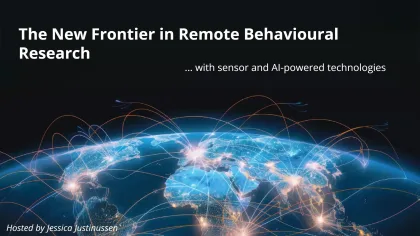We spend all day, every day around human-created objects, experiences and environments. For human behavior researchers, understanding how people react to these is a source of endless discovery. Studying nonconscious human perception and behavior therefore has the potential to shift every commercial industry.
How we understand architecture
Architecture is one such field that is on the cusp of huge changes in how we explain and understand it. A growing body of research is showing how architecture and urban design create physiological responses in people that promote long-term health and well-being. If we don’t measure and seek to understand this impact, then we’re potentially creating environments that don’t promote this well-being and are unhealthy.
This is what iMotions client Ann Sussman of the Human Architecture and Planning Institute, Inc, a Boston-based research non-profit, works on. She campaigns for further studying neuroscience in architecture to show the world that buildings should be human-centered — and how modern built environments tend not to be. In this “Path to Publication” webinar, she showcases several of her published biosensor findings highlighting the interplay between buildings and well-being, including how biometric research reveals our innate face-bias and ’seeing’ this trait reframes the history of how blank, detail-free, modern architecture came to be.
The webinar is a must-see for researchers across industries who are looking to communicate their passion for human behavior research and create a paradigm shift promoting neuroscience within their fields.
Have you published research using the iMotions software and want to participate in the webinar series? Reach out to marketing@imotions.com.
Summary
Ann Sussman’s talk, titled “Designing for the Subliminal Brain Architecture with a 21st Century Paradigm Shift,” explores how biometric research (eye tracking, facial expression analysis, heart rate variability, etc.) can revolutionize our understanding of architecture. Framing her discussion within the context of the “age of biology,” Ann contrasts the past eras of engineering (19th century) and chemistry/physics (20th century) with today’s need to design for our biological nature.
Using several pilot studies and visual data, she demonstrates that architectural elements—such as statues, windows, or even the “face” of a building—capture attention at a subliminal level. For example, eye tracking studies reveal how quickly and unconsciously people fixate on these features, uncovering patterns that traditional self-reports or design assumptions often miss.
Ann also challenges modern design trends, noting that faceless or overly minimal facades may fail to provide the innate cues our brains need for safety, orientation, and emotional comfort. She argues that the trauma of historical events (like World War I) has even influenced modern architecture, leading to designs that can feel alienating compared to traditional, detailed facades.
Throughout the presentation, Ann emphasizes that understanding these unconscious, biological responses is essential. By leveraging biometric research, architects and designers can create spaces that are not only aesthetically pleasing but also support mental well-being and community engagement.
Key Takeaways
- Biological Underpinnings of Perception:
Our unconscious, evolutionary biology governs how we visually and emotionally engage with spaces. Eye tracking data shows that people naturally fixate on features that mimic human faces or provide clear visual cues. - The 21st Century Paradigm Shift:
We are moving from an era dominated by engineering and technology to one that prioritizes biology. Design should now account for the inherent needs of our brain and nervous system. - Designing for the Subliminal Brain:
Biometric tools can reveal what we see before we consciously register it. This insight allows architects to design environments that intuitively guide attention and evoke positive emotional responses. - Contrast Between Traditional and Modern Architecture:
Traditional buildings—with their detailed, “face-like” features—provide the visual anchors that help people feel oriented and welcome. In contrast, many modern, blank facades may lack these cues, potentially contributing to feelings of disconnection or stress. - Trauma’s Influence on Design:
Historical trauma, such as the impact of World War I on architects, may have shaped modern architectural trends, resulting in designs that unconsciously mirror stress or avoidance behaviors. - Practical Applications of Biometric Research:
Using platforms like iMotions, designers can quantitatively assess how subtle changes in architectural elements affect human behavior. This data-driven approach can lead to environments that promote safety, well-being, and community interaction. - Vision for the Future:
By understanding and applying these biometric insights, architects have the potential to profoundly impact public health—arguably even more so than traditional medical interventions. The ultimate goal is to create spaces that not only function well but also nurture our inherent need for connection and security.
This webinar underscores that when we design with an understanding of our biological and unconscious processes, we can transform the built environment into spaces that truly support and enhance human well-being.







